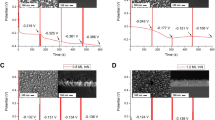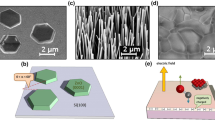Abstract
Silicon nanowires are expected to have applications in transistors, sensors, resonators, solar cells and thermoelectric systems1,2,3,4,5. Understanding the surface properties and dopant distribution will be critical for the fabrication of high-performance devices based on nanowires6. At present, determination of the dopant concentration depends on a combination of experimental measurements of the mobility and threshold voltage7,8 in a nanowire field-effect transistor, a calculated value for the capacitance, and two assumptions—that the dopant distribution is uniform and that the surface (interface) charge density is known. These assumptions can be tested in planar devices with the capacitance–voltage technique9. This technique has also been used to determine the mobility of nanowires10,11,12,13, but it has not been used to measure surface properties and dopant distributions, despite their influence on the electronic properties of nanowires14,15. Here, we measure the surface (interface) state density and the radial dopant profile of individual silicon nanowire field-effect transistors with the capacitance–voltage technique.
This is a preview of subscription content, access via your institution
Access options
Subscribe to this journal
Receive 12 print issues and online access
$259.00 per year
only $21.58 per issue
Buy this article
- Purchase on Springer Link
- Instant access to full article PDF
Prices may be subject to local taxes which are calculated during checkout




Similar content being viewed by others
References
Cui, Y., Wei, Q. Q., Park, H. K. & Lieber, C. M. Nanowire nanosensors for highly sensitive and selective detection of biological and chemical species. Science 293, 1289–1292 (2001).
Feng, X. L., He, R. R., Yang, P. D. & Roukes, M. L. Very high frequency silicon nanowire electromechanical resonators. Nano Lett. 7, 1953–1959 (2007).
Kayes, B. M., Atwater, H. A. & Lewis, N. S. Comparison of the device physics principles of planar and radial p–n junction nanorod solar cells. J. Appl. Phys. 97, 114302 (2005).
Garnett, E. C. & Yang, P. D. Silicon nanowire p–n junction solar cells. J. Am. Chem. Soc. 130, 9224–9225 (2008).
Hochbaum, A. I. et al. Enhanced thermoelectric performance of rough silicon nanowires. Nature 451, 163–168 (2008).
Law, M., Goldberger, J. & Yang, P. D. Semiconductor nanowires and nanotubes. Ann. Rev. Mater. Res. 34, 83–122 (2004).
Goldberger, J., Hochbaum, A. I., Fan, R. & Yang, P. D. Silicon vertically integrated nanowire field effect transistors. Nano Lett. 6, 973–977 (2006).
Cui, Y., Duan, X. F., Hu, J. T. & Lieber, C. M. Doping and electrical transport in silicon nanowires. J. Phys. Chem. B 104, 5213–5216 (2000).
Nicollian, E. H. & Brews, J. R. in MOS Physics and Technology 1–903 (Wiley-Interscience, 1982).
Tu, R., Zhang, L., Nishi, Y. & Dai, H. J. Measuring the capacitance of individual semiconductor nanowires for carrier mobility assessment. Nano Lett. 7, 1561–1565 (2007).
Gunawan, O. et al. Measurement of carrier mobility in silicon nanowires. Nano Lett. 8, 1566–1571 (2008).
Khanal, D. R. & Wu, J. Gate coupling and charge distribution in nanowire field effect transistors. Nano Lett. 7, 2778–2783 (2007).
Roddaro, S. et al. InAs nanowire metal-oxide semiconductor capacitors. Appl. Phys. Lett. 92, 253509–253511 (2008).
Haick, H., Hurley, P. T., Hochbaum, A. I., Yang, P. D. & Lewis, N. S. Electrical characteristics and chemical stability of non-oxidized, methyl-terminated silicon nanowires. J. Am. Chem. Soc. 128, 8990–8991 (2006).
Schmidt, V., Senz, S. & Gosele, U. Influence of the Si/SiO2 interface on the charge carrier density of Si nanowires. Appl. Phys. A—Mater. Sci. Proc. 86, 187–191 (2007).
He, R. R. et al. Si nanowire bridges in microtrenches: Integration of growth into device fabrication. Adv. Mater. 17, 2098–2102 (2005).
He, R. & Yang, P. Giant piezoresistance effect in silicon nanowires. Nature Nanotech. 1, 42–46 (2006).
Zhang, R. Q. et al. Structures and energetics of hydrogen-terminated silicon nanowire surfaces. J. Chem. Phys. 123, 144703 (2005).
Wagner, R. S. & Ellis, W. C. Vapor–liquid–solid mechanism of single crystal growth. Appl. Phys. Lett. 4, 89–90 (1964).
Ilani, S., Donev, L. A. K., Kindermann, M. & McEuen, P. L. Measurement of the quantum capacitance of interacting electrons in carbon nanotubes. Nature Phys. 2, 687–691 (2006).
Wilk, G. D., Wallace, R. M. & Anthony, J. M. High-kappa gate dielectrics: Current status and materials properties considerations. J. Appl. Phys. 89, 5243–5275 (2001).
Truong, L., Fedorenko, Y. G., Afanasev, V. V. & Stesmans, A. Admittance spectroscopy of traps at the interfaces of (100)Si with Al2O3, ZrO2 and HfO2 . Microelectron. Reliability 45, 823–826 (2005).
Duenas, S. et al. Influence of single and double deposition temperatures on the interface quality of atomic layer deposited Al2O3 dielectric thin films on silicon. J. Appl. Phys. 99, 054902 (2006).
Garnett, E. C., Liang, W. J. & Yang, P. D. Growth and electrical characteristics of platinum-nanoparticle-catalyzed silicon nanowires. Adv. Mater. 19, 2946–2950 (2007).
Wu, Y. et al. Controlled growth and structures of molecular-scale silicon nanowires. Nano Lett. 4, 433–436 (2004).
Terman, L. M. An investigation of surface states at a silicon silicon oxide interface employing metal oxide silicon diodes. Solid-State Electron. 5, 285–299 (1962).
Kennedy, D. P., Murley, P. C. & Kleinfel, W. On measurement of impurity atom distributions in silicon by differential capacitance technique. IBM J. Res. Dev. 12, 399–400 (1968).
Kennedy, D. P. & Obrien, R. R. On measurement of impurity atom distributions by differential capacitance technique. IBM J. Res. Dev. 13, 212–213 (1969).
Acknowledgements
E.C.G. would like to thank the National Center for Electron Microscopy for use of their facilities, M. Fardy for help with FIB milling and Z. Zhang for help with imaging. Portions of this work were performed under the auspices of the National Science Foundation by University of California Berkeley under grant no. 0425914. The authors acknowledge the support of the MSD Focus Center, funded under the FCRP program of the Semiconductor Research Corporation.
Author information
Authors and Affiliations
Corresponding author
Supplementary information
Supplementary Information
Supplementary Information (PDF 601 kb)
Rights and permissions
About this article
Cite this article
Garnett, E., Tseng, YC., Khanal, D. et al. Dopant profiling and surface analysis of silicon nanowires using capacitance–voltage measurements. Nature Nanotech 4, 311–314 (2009). https://doi.org/10.1038/nnano.2009.43
Received:
Accepted:
Published:
Issue Date:
DOI: https://doi.org/10.1038/nnano.2009.43
This article is cited by
-
Electrical Properties of Silicon Nanowires Schottky Barriers Prepared by MACE at Different Etching Time
Silicon (2022)
-
Photoelectrochemical modulation of neuronal activity with free-standing coaxial silicon nanowires
Nature Nanotechnology (2018)
-
Modulation Doping of Silicon using Aluminium-induced Acceptor States in Silicon Dioxide
Scientific Reports (2017)
-
Controllable synthesis of p-type Cu2S nanowires for self-driven NIR photodetector application
Journal of Nanoparticle Research (2017)
-
Metal-assisted chemical etching of silicon and the behavior of nanoscale silicon materials as Li-ion battery anodes
Nano Research (2015)



